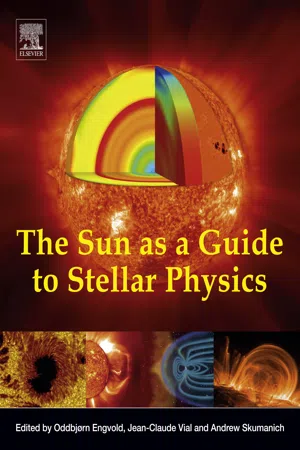
The Sun as a Guide to Stellar Physics
- 522 pages
- English
- ePUB (mobile friendly)
- Available on iOS & Android
The Sun as a Guide to Stellar Physics
About this book
The Sun as a Guide to Stellar Physics illustrates the significance of the Sun in understanding stars through anexamination of the discoveries and insights gained from solar physics research. Ranging from theories to modelingand from numerical simulations to instrumentation and data processing, the book provides an overview of whatwe currently understand and how the Sun can be a model for gaining further knowledge about stellar physics.Providing both updates on recent developments in solar physics and applications to stellar physics, this bookstrengthens the solar–stellar connection and summarizes what we know about the Sun for the stellar, space, andgeophysics communities.- Applies observations, theoretical understanding, modeling capabilities and physical processes first revealed by the sun to the study of stellar physics- Illustrates how studies of Proxima Solaris have led to progress in space science, stellar physics and related fields- Uses characteristics of solar phenomena as a guide for understanding the physics of stars
Frequently asked questions
- Essential is ideal for learners and professionals who enjoy exploring a wide range of subjects. Access the Essential Library with 800,000+ trusted titles and best-sellers across business, personal growth, and the humanities. Includes unlimited reading time and Standard Read Aloud voice.
- Complete: Perfect for advanced learners and researchers needing full, unrestricted access. Unlock 1.4M+ books across hundreds of subjects, including academic and specialized titles. The Complete Plan also includes advanced features like Premium Read Aloud and Research Assistant.
Please note we cannot support devices running on iOS 13 and Android 7 or earlier. Learn more about using the app.
Information
Discoveries and Concepts
The Sun's Role in Astrophysics
Abstract
Keywords
1. The Solar Constant

2. The Sun's Chemical Composition
2.1. Spectroscopic Methods
Table of contents
- Cover image
- Title page
- Table of Contents
- Copyright
- List of Contributors
- Preface
- Chapter 1. Discoveries and Concepts: The Sun's Role in Astrophysics
- Chapter 2. Stellar and Solar Chromospheres and Attendant Phenomena
- Chapter 3. The Sun's Atmosphere
- Chapter 4. Helioseismic Inferences on the Internal Structure and Dynamics of the Sun
- Chapter 5. Atmospheric structure, Non-Equilibrium Thermodynamics and Magnetism
- Chapter 5.2. Models of Solar and Stellar Atmospheres
- Chapter 5.3. Spectropolarimetry and Magnetic Structures
- Chapter 6. Coronal Magnetism as a Universal Phenomenon
- Chapter 7. Magnetohydrodynamics and Solar Dynamo Action
- Chapter 8. Solar and Stellar Variability
- Chapter 9. High-Energy Solar Physics
- Chapter 10. Space Weather at Earth and in Our Solar System
- Chapter 11. The Solar–Stellar Connection
- Chapter 12. Instrumentation
- Chapter 12.2. High-Resolution Ground-Based Observations of the Sun
- Chapter 13. Solar Data and Simulations
- Chapter 14. Challenges and Prospects for the Future
- Author Index
- Subject Index